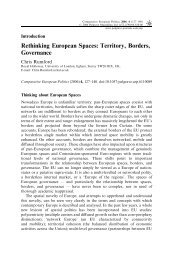Europeanisation, National Identities and Migration ... - europeanization
Europeanisation, National Identities and Migration ... - europeanization
Europeanisation, National Identities and Migration ... - europeanization
You also want an ePaper? Increase the reach of your titles
YUMPU automatically turns print PDFs into web optimized ePapers that Google loves.
140 Willfried Spohn<br />
The consequence of these stereotypical fears on both sides is that the accession<br />
of Pol<strong>and</strong> to the European Union – in all probability in 2004 – will be accompanied,<br />
at the request of the German <strong>and</strong> Polish governments, by a transition period of<br />
about four to seven years in which Poles will have only limited access to the Western<br />
European labour market <strong>and</strong> foreigners will be restricted in buying Polish l<strong>and</strong>.<br />
Yet, these delaying measures will apply only temporarily <strong>and</strong> the full accession of<br />
Pol<strong>and</strong> will prove that the stereotypical fears on the German <strong>and</strong> the Polish sides<br />
are grossly exaggerated. It is not the case that Poles, who will find growing<br />
opportunities in their own country, will be motivated to emigrate in growing<br />
numbers to Germany, nor are the Germans, who are only to a very small degree<br />
still farmers, particularly interested in Polish l<strong>and</strong>. On the contrary, the Eastern<br />
enlargement will accelerate the economic exchange <strong>and</strong> interconnection between<br />
both countries, continuing – but with a diminishing power hierarchy – a West–East<br />
German–Polish gradient. In addition, the membership by the East Central<br />
European countries of the European Union will even more than now counterbalance<br />
the political weight of the large Western European states by the many<br />
small states. With it also, the still existing power hierarchy between Germany <strong>and</strong><br />
Pol<strong>and</strong> will be further reduced. Finally, the accession of Pol<strong>and</strong> to the European<br />
Union will also offer more opportunities for an increased cultural exchange between<br />
the two countries. Even if these opportunities are taken up, this will probably not<br />
mean a complete reversal of the cultural hierarchy between the two countries: the<br />
high level of interest by Poles in German <strong>and</strong> Western cultures <strong>and</strong> languages <strong>and</strong><br />
the low interest of Germans in Polish culture <strong>and</strong> language. But an increasing<br />
cultural exchange would be the only way to further reduce the still present <strong>and</strong> often<br />
unconscious national missionary overtones <strong>and</strong> stereotypical fears in both nations<br />
by a common participation in a multiple European culture.<br />
Notes<br />
1 For a political study see Bingen 1997; for a critical analysis, Krzeminski 2001.<br />
2 For political-sociological studies see Hanson <strong>and</strong> Spohn 1995; Katzenstein 1977, 1998;<br />
<strong>and</strong> Markovits <strong>and</strong> Reich 1997.<br />
3 For an overview see Spohn 2000a.<br />
4 European historical-comparative approaches are Schieder 1992; Schulze 1994; <strong>and</strong><br />
Smith 1986.<br />
5 Amongst others see particularly Conze 1992; Dann 1993.<br />
6 See with extensive literature Spohn 1995.<br />
7 This is my central thesis in Spohn forthcoming.<br />
8 For a study on the Eastern German border regions, see Baranowski 1995.<br />
9 The following figures are based on Benz 1992: 413–19; Dimitrow 1992: 420–7.<br />
10 On post-Second World War German–Polish relations see Rosenthal 1976.<br />
11 As a recent interpretation of German history after 1945 see Winkler 2001.<br />
12 Among others see particularly Berghahn 1987; Conze <strong>and</strong> Lepsius 1984; Dahrendorf<br />
1965.<br />
13 See, among others Childs 1988; Glaeßner 1989; Kaelble <strong>and</strong> Kocka 1994.<br />
14 See particularly Davies 1981: 556–663; Hoensch 1990; Krzeminski 1991.<br />
15 Bingen 1999: 175–6. The Polish GDP/FDI ratio is however considerably lower than<br />
the Hungarian one; see Greskovits <strong>and</strong> Bohle 2001: 3–27.



